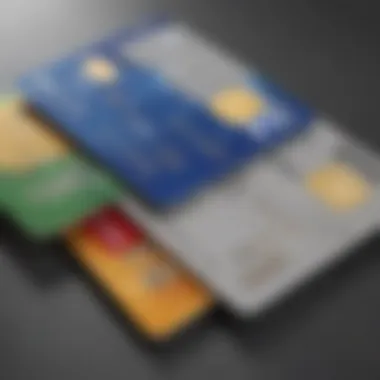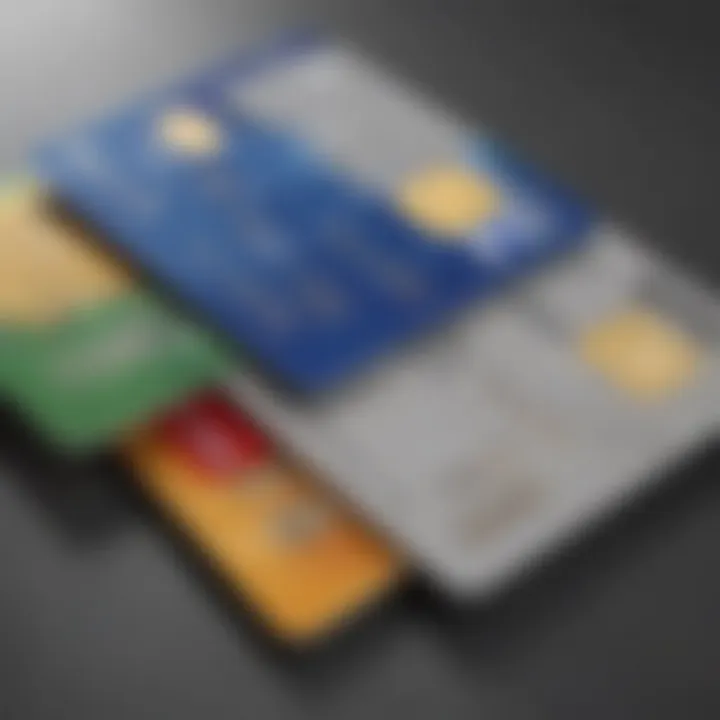Navigating Euro Debit Cards in the U.S. Market


Intro
In today’s interconnected world, the ability to manage finances across borders has become essential, particularly for those navigating life between the United States and Europe. Euro debit cards are gaining traction, offering a convenient method for individuals to access funds while minimizing potential pitfalls associated with currency exchanges and international transactions. This section aims to provide the groundwork for understanding the significance of these financial tools, making sense of their operation, benefits, and limitations.
Firstly, it’s important to establish the operational structure of Euro debit cards. These cards function similarly to their Dollar counterparts but operate within a different financial framework. They allow users to withdraw cash at ATMs, make purchases in shops, or pay for services online without jumping through too many hoops. Yet, there are a few nuances that users must keep in mind.
Moreover, this article aims to highlight the various legal considerations in the U.S. concerning Euro debit cards. Navigating the fine print of usage fees, transaction charges, and foreign exchange rates is critical for optimizing the experience. Therefore, this careful exploration will serve not only as a guide for tourists but also for expatriates or those with financial ties to Europe.
With that in mind, let’s delve deeper into the fundamental key terms and definitions that anchor our discussion about Euro debit cards.
Key Terms and Definitions
Understanding the jargon related to Euro debit cards is essential in order to grasp fully how they operate in the U.S. Here’s a rundown of the most pertinent terms:
Explanation of Investment Terminology
- Foreign Currency Exchange Rate: This refers to the value of one currency compared to another. If you're using a Euro debit card in the U.S., understanding this can help you gauge how much you are actually spending.
- Transaction Fees: These are costs incurred each time the card is used. Depending on the bank or provider, fees may vary widely.
- Cross-Border Fees: When transactions occur outside your home country, additional fees may apply. It’s like adding a pinch of salt to your financial recipe—sometimes necessary, sometimes avoidable.
- ATM Charges: When withdrawing cash, users might face charges from both the ATM owner and their bank, depending on the card's agreements.
Commonly Used Financial Products
- Euro Debit Cards: Primarily used by individuals who hold Euro accounts or who travel frequently to Europe.
- Credit Cards: While different from debit cards, many travelers opt for credit cards because they often have better fraud protection and rewards.
- Prepaid Travel Cards: These can sometimes offer a more straightforward method for loading money and using it in various currencies without the immediate connection to a bank account.
"In the era of globalization, managing your finances across multiple currencies can feel like walking a tightrope, but with the right tools, balance can be achieved."
Armed with these definitions, one can begin to see the landscape of financial transactions with greater clarity. Next, we will explore how these cards function in practice, along with a detailed examination of their potential benefits and inherent limitations.
Foreword to Euro Debit Cards
Euro debit cards represent a vital intersection of global finance and personal spending. With increasing global mobility, a solid grasp of how these cards function within the U.S. context is essential for anyone who travels frequently or engages with European commerce. Understanding the nuances of Euro debit cards not only aids travelers in managing their budgets more effectively but also helps residents avoid pitfalls associated with currency exchange and transaction fees.
Defining Euro Debit Cards
At its core, a Euro debit card is linked to a bank account denominated in euros. This means transactions are processed in euros, bringing certain peculiarities when used in a country like the United States, where the primary currency is the U.S. dollar. When a user swipes their Euro debit card for a purchase, the amount is directly withdrawn from their euro account, potentially saving time and costs associated with currency exchanges.
Additionally, many Euro debit cards offer international acceptance, allowing them to be used at ATMs and points of sale that accept major payment networks like Visa or Mastercard. This can be particularly beneficial for those who might otherwise face hefty fees for currency conversion or foreign transaction charges with local debit cards, making it a smart option for budget-conscious individuals.
Evolution of Payment Methods
Payment methods have shifted dramatically over the years, influenced by technological advancements and changing consumer preferences. Once upon a time, cash was king; people carried their money in wallets and exchanged coins for goods and services. The rise of credit cards commenced in the mid-20th century, introducing a credit-based system and promoting increased spending power.
In more recent years, with the internet becoming a fixture in everyday life, digital wallets and online banking have surged, allowing for transactions that cross borders with just a click. Euro debit cards exemplify this evolution, merging ease-of-use with international access. With the convenience of being able to spend in euros without exchanging currency, these cards have emerged as a necessity for travelers and expatriates alike.
"The modern consumer demands not just convenience, but also flexibility; Euro debit cards deliver just that, making cross-border handling of finances as smooth as possible."
To sum up, grasping the essence of Euro debit cards and their evolution certainly lays the groundwork for understanding their current role in international transactions, particularly within the United States. As we further explore the mechanisms, advantages, and challenges associated with these cards, it’s clear that they will continue to influence the landscape of global finance.
The Mechanism of Euro Debit Cards
In the realm of financial transactions, understanding the mechanisms of Euro debit cards provides clarity on how they operate within the United States. This section dives deep into the processes that drive these cards, illuminating their functionality for users. By grasping how transactions occur and how currency conversions are handled, individuals can make informed choices about their spending habits and financial management in a cross-border context.
How Transactions Work
At its core, the transaction process with Euro debit cards is designed to be as seamless as possible. When a user makes a purchase, whether it's at a grocery store or an online retailer, the card effectively withdraws funds from the user’s bank account. This is executed almost instantaneously, with the merchant receiving a confirmation of the transaction within seconds. Currently, many places in the U.S. accept contactless payment methods; consequently, Euro debit cards may be used similarly, allowing for quick tap-and-go transactions.
However, it's crucial to note the differences that come into play when using a Euro debit card in the States. While using the card, the user must ensure that the transaction is processed in euros rather than dollars to avoid potential unfavorable conversions at the point of sale.
A few key points to keep in mind include:
- Notifications are often sent directly to the mobile banking app regarding transaction confirmations.
- Users may receive foreign transaction fees depending on their card provider.
- Transactions can sometimes be flagged for review by the bank to combat fraud, which can delay the payment process.
Currency Conversion Processes


Currency conversion can often be the fly in the ointment when dealing with Euro debit cards in the U.S. The vital aspect here is understanding how your euro translates to the dollar at the point of sale. Generally, transactions will follow one of two paths:
- Dynamic Currency Conversion (DCC): Some merchants offer the option to bill in euros or dollars. Customers might be lured into DCC because it provides immediate clarity on how much money is being spent in their home currency. However, DCC usually comes with a higher conversion fee attached, which can lead to regrettable overspending.
- International Card Transaction Rates: If opting to pay in euros, the cardholder's bank will handle the conversion. This often results in a more favorable exchange rate than DCC because banks generally utilize the mid-market rate, plus any additional fees that the bank itself might charge.
"Understanding currency conversion processes is pivotal for anyone wanting to maximize their savings while using Euro debit cards in the U.S."
Ultimately, being aware of these conversion methods is essential. It allows the cardholder to strategize their purchases, ensuring they're not caught off guard by excessive charges or poor exchange rates. Knowledge is power, especially in the world of international finance.
Advantages of Using Euro Debit Cards in the U.S.
When discussing Euro debit cards in the United States, it's vital to highlight the advantages that these financial tools offer. There’s quite a bit of nuance when employing these cards, and understanding these benefits can be essential for anyone looking to make the most out of their international finances, whether you’re a resident or a traveler.
*
Cost Efficiency and Savings
One standout feature of Euro debit cards is their cost efficiency. Many users find that using a Euro debit card while in the U.S. can lead to significant savings, particularly concerning foreign transaction fees. Unlike some U.S.-based cards that impose hefty charges for international transactions, Euro debit cards often come with more favorable rates.
Furthermore, certain banks maintain partnerships that allow for surcharge-free withdrawals or lower fees when withdrawing cash at ATMs in different countries. This can drastically reduce costs—sometimes even eliminating fees altogether. Additionally, the exchange rate applied when using the Euro debit card might be better than what you’d receive from currency exchanges, giving you a bang for your buck.
Key Points:
- Lower or no foreign transaction fees.
- Potential for more favorable exchange rates.
- Cost-effective ATM access abroad.
"Choosing to use a Euro debit card can turn out to be financially savvy, especially when navigating multiple currencies."
By benefiting from these cost efficiencies, users can stretch their funds further while traveling or living in the U.S., allowing them to focus on enjoying their experiences rather than worrying about finances.
Convenience for International Transactions
When it comes to convenience, Euro debit cards are hard to beat. For those making frequent international transactions, whether for work or leisure, these cards serve as a convenient bridge across borders. Users don’t need to constantly switch between multiple cards or worry about finding compatible payment methods—one card works in many places, providing peace of mind.
Adding to this is the fact that many retailers and service providers in the U.S. are increasingly accepting Euro debit cards. This makes it easy to shop, dine, or pay for services without needing to convert currencies prior to a purchase or transaction.
Advantages for Travelers:
- Instant access to funds in Euro.
- Reduced hassle with currency conversion.
- Broad acceptance among various vendors.
With a Euro debit card, individuals can make purchases and access funds without having to engage in cumbersome steps like finding a currency exchange or dealing with varying rates. This level of simplicity aligns well with today’s fast-paced lifestyle, where time is of the essence, and convenience is king.
Challenges and Limitations
Understanding the challenges and limitations of Euro debit cards is crucial for anyone considering using them in the United States. While these cards offer many advantages, there are also significant drawbacks that potential users must be aware of. Being informed helps consumers make better financial decisions and avoids pitfalls that could lead to unexpected costs or frustrations.
Understanding Fees and Charges
When you swipe your Euro debit card, you might feel as though you’re just tapping away like a pro, but the fees can pile up in surprising ways. Often, there's a foreign transaction fee for using the card outside of its country of issue. These charges can vary widely among different banks and card providers. For instance, some card issuers might slap on a fee for every transaction, while others might offer a certain number of free transactions within a specific timeframe.
It's also worth keeping in mind that while your Euro debit card might save you from hefty currency conversion fees to an extent, other hidden charges can bite. These may include ATM withdrawal fees if you're pulling cash from machines operated by different banks. Cumulatively, these costs can take a toll on your savings, especially for frequent travelers or individuals who rely on these cards for their daily transactions. To navigate through these charges, it's wise to read the fine print and ask questions to your card issuer before making a decision.
"Knowing what you’re signing up for can make the difference between saving money and losing it with each swipe."
Limited Acceptance Among Merchants
Another hiccup comes from the acceptance of Euro debit cards at retail and online merchants in the U.S. While many major retailers and e-commerce platforms do accept international cards, others may not, leaving you in a bit of a bind when you're at the checkout counter.
There are some merchants who only work with cards issued by U.S. banks, leading to potential frustrations when your Euro debit card isn't accepted. This can be particularly jarring in smaller towns or with less-known brands.
It's a good idea to carry an additional payment option—be it cash, a U.S. credit card, or even a prepaid debit card—while traveling or shopping in case your Euro debit card is turned down.
In summary, even though Euro debit cards can be a nifty asset for your finances, understanding the pro and cons will help you sidestep complications down the road. Staying ahead of the game in terms of fees and where you can actually use your card can save you on more than just your monthly statements.
Regulatory Considerations


Understanding regulatory considerations is crucial when it comes to using Euro debit cards in the U.S. Given the complex characteristics of cross-border transactions, the interplay between different financial regulations can have a substantial impact on user experience and security.
U.S. Financial Regulations
The U.S. exhibits a diverse set of financial regulations that govern how banks and financial institutions operate. These rules can influence the way Euro debit cards work for both locals and travelers.
For instance, the Bank Secrecy Act requires institutions to assist government agencies in detecting and preventing money laundering. This means that when users engage in transactions with Euro debit cards, there might be additional scrutiny. It can cause delays or even prompt questions about the legitimacy of a transaction. Also, the Federal Reserve’s rules regarding international transactions can lead to variations in fees and exchange rates applied by U.S. banks.
Moreover, cross-border regulations encompass such aspects as customer identification standards, which aim to combat fraud. As a result, when individuals from Europe use their debit cards, they may be asked to provide additional forms of identification. This requirement might feel confusing, especially for those accustomed to more streamlined practices back home.
Consumer Protection Laws
In addition to financial regulations, consumer protection laws in the U.S. play a pivotal role in safeguarding users. These laws are designed to protect consumers from unfair treatment, fraud, and other financial misconducts. The Truth in Lending Act is a notable example, as it compels lenders to disclose essential information regarding card fees and interest rates before a transaction occurs.
When accessing Euro debit cards, users can benefit from these laws, as they empower consumers with information. It allows them to make informed decisions about their financial choices. Moreover, laws like the Electronic Fund Transfer Act provide users with clear frameworks surrounding personal liability for lost or stolen cards. Generally, if a card gets lost or used without permission, the law limits consumers’ liability, provided they report it promptly.
Having such legislative safeguards may instill more confidence for Euro debit card users venturing into the American market.
"Navigating financial regulations can be tricky, but they ultimately serve to protect users and promote fair practices across the board."
Utilizing Euro Debit Cards for Travel
Traveling with a Euro debit card can be a game changer. It’s about more than just convenience; it’s about making the most of your finances while you explore new terrains. European debit cards often provide better exchange rates than traditional banks, letting you stretch your dollars further. For those who pass through Europe frequently or temporarily reside there, using a Euro debit card helps eliminate hefty transaction fees. Considerations like these can turn a good trip into a great one.
Best Practices for Travelers
When it comes to using Euro debit cards, there are several best practices to keep in mind for a smooth experience:
- Notify Your Bank: Before embarking on your journey, give your bank a heads up. Informing them of your travel plans can prevent any surprises, like your card being blocked due to what’s perceived as suspicious activity.
- Understand Your Card Features: Each Euro debit card can have its own set of perks and quirks. Some might offer free transactions at ATMs abroad, while others may not. Familiarizing yourself with these details can save you time and stress on your trip.
- Utilize Contactless Payments: In many European countries, contactless payments are widely accepted. Using this feature can streamline your purchases—just tap and go!
- Keep Backup Payment Options: While relying on a single card can be tempting, it’s best to carry an alternative. This can be a second card or cash. If your primary card gets lost or misunderstood, you’re not left stranded.
Currency Risks While Traveling
Traveling with a Euro debit card isn't all sunshine and rainbows; it comes with its own set of risks. Here are some currency-related hazards to be aware of:
- Exchange Rate Fluctuations: Exchange rates can swing like a pendulum. If you're making large transactions, even slight shifts can have a big impact on the amount deducted from your account. Consider keeping an eye on rates or using apps that show current currency values.
- ATM Fees: Searching for the right ATM can often lead you down a rabbit hole. Some machines could impose high fees that you weren’t expecting, especially if they are not part of your card’s network. It pays to do a bit of research before selecting an ATM.
- Dynamic Currency Conversion: Sometimes merchants offer to convert the price into your home currency at the point of sale. This seems tempting, but typically, their rates are not favorable. Always choose to pay in the local currency to avoid inflated costs.
"Using a Euro debit card while travelling can simplify your transactions, but being aware of potential pitfalls can save you a lot of money in the long run."
In summary, using Euro debit cards while travelling can provide a significant advantage, but understanding best practices and inherent risks can lead to a more enjoyable and financially savvy trip. Being prepared is half the battle, so get your ducks in a row before you head out.
Comparing Euro Debit Cards with Local Options
As financial landscapes continue to evolve, the comparison between Euro debit cards and local debit cards in the U.S. becomes increasingly important. This section aims to dissect the differences elucidating why consumers should carefully consider each option based on various elements. Understanding these distinctions can lead to significant benefits, particularly for travelers and expatriates who traverse between the Eurozone and the United States. With varying features and conditions, knowing what each card type offers may influence personal finance strategies, convenience, and cost savings.
Features of Local Debit Cards
Local debit cards are typically tailored to the U.S. market, which means they come with a set of features that cater to everyday needs. Key features often include:
- Widespread Merchant Acceptance: Local cards are generally accepted by the majority of merchants across the U.S. This can be crucial for everyday purchases where Euro cards might not be recognized.
- ATM Access: While Euro debit cards may have a limited network of ATMs, local cards often provide extensive ATM networks, often with lower withdrawal fees or none at all in the case of in-network transactions.
- Rewards Programs: Many U.S. banks offer lucrative rewards programs linked to their debit cards, providing cash back or points for every dollar spent. This may not be as commonly available with Euro debit cards.
- U.S. Currency Transactions: Paying in U.S. dollars directly eliminates conversion fees when using local debit cards, streamlining transactions and reducing misunderstandings about costs.
These features can present a strong case for local debit cards, particularly for individuals who primarily reside in the U.S.
Fee Structures: Euro vs Local Cards
When considering the financial implications of using a Euro debit card versus a local U.S. card, fee structures play a pivotal role. Differences in fees may not only impact spending habits but also the overall financial health of the user. Here are some key differences:
- Foreign Transaction Fees: Euro debit cards often incur foreign transaction fees when used outside of the Eurozone or in non-euro-denominated transactions. This can add up and sometimes lead to higher costs.
- ATM Withdrawal Fees: While U.S. debit cards may come with fewer or more lenient withdrawal fees, Euro debit cards frequently have higher fees for ATM withdrawals, especially if they are out of network.
- Currency Conversion Rates: The exchange rate applied when using a Euro debit card can vary significantly. Banks often mark up the conversion rate, which can lead to customers paying more than anticipated.
- Monthly Maintenance or Service Fees: Some local debit cards hold no minimum balance requirements or service fees, while certain Euro debit cards may include monthly costs that add to overall expenditure.
Understanding these fee structures is essential for budgeting and financial planning. Making an informed choice requires careful consideration of how often you may be using the card, the transaction types you engage in, and how that relates to your personal financial goals.
"Comparing debit cards is not just about fees and features; it's about aligning your financial tools with your lifestyle."
In summary, while Euro debit cards possess their own unique strengths often beneficial for international users, local debit options can be more straightforward for daily transactions in the U.S. Ultimately, weighing both options against individual needs is critical for making sound financial decisions.


Choosing the Right Euro Debit Card
Selecting an appropriate Euro debit card is a crucial step for individuals navigating financial transactions across borders. With a wide range of options available, understanding the nuances of different cards can significantly affect your experience, both in terms of cost and convenience. Knowing what to look for can set the foundation for seamless usage while maximizing benefits tailored to specific needs.
Factors to Consider
When choosing a Euro debit card, there are several key elements that deserve attention. Here are some primary considerations:
- Fees: Always check the breakdown of fees attached to any card you consider. This includes annual fees, transaction fees, and foreign exchange charges. Some banks or providers might have hidden costs that sneak up on naive users.
- Acceptance: Not every card is accepted everywhere. It’s vital to inquire about the card's acceptance in the U.S. and Europe. Cards from the major networks like Visa and Mastercard tend to be more widely accepted.
- Withdrawal Limits: Each card may have different daily or monthly withdrawal limits. If you're traveling or need cash frequently, ensure that your chosen card meets your withdrawal needs.
- Currency Conversion Rate: The rate at which the card provider converts Euros to U.S. dollars can significantly impact the overall cost of transactions. A favorable rate can mean more money in your pocket.
- Security Features: Opt for cards that offer robust security measures, such as alerts, encryption, and the ability to freeze accounts. This can provide peace of mind, especially when traveling.
Taking these factors into account ensures not only that you select a card that suits your financial habits but also that you avoid unexpected surprises down the line.
Popular Euro Debit Card Providers
With various financial institutions providing Euro debit cards, it helps to know which players are prominent in the market. Here are some noteworthy options:
- Revolut: Known for its no-fee international transactions and favorable exchange rates, Revolut has grown its customer base rapidly. Users can hold multiple currencies in one account, allowing for flexibility when traveling.
- TransferWise (now Wise): Wise prides itself on transparency and offers competitive, real-time exchange rates. Moreover, the card can be simply managed via an intuitive app, appealing to tech-savvy users.
- N26: This mobile bank offers an elegant design and seamless banking experience. With N26, account holders can spend abroad with minimal fees attached.
- Monzo: Particularly popular in Europe, Monzo combines standard banking services with modern features, allowing users to make transactions without hefty fees.
All these providers cater to slightly different demographics, which means that assessing personal needs will help streamline the decision-making process. Individuals should evaluate each contender based on how closely they align with their spending habits and travel patterns.
Customer Support and Assistance
Navigating the world of Euro debit cards in the United States can be a tricky landscape, and this makes customer support absolutely vital. When individuals encounter issues—whether it's technical difficulties, questions regarding fees, or errors in transactions—having access to reliable support can make all the difference between a seamless experience and a frustrating ordeal.
The importance of effective customer support cannot be overstated. Users need assistance that is not only available at their fingertips but also knowledgeable about the specifics of Euro debit cards. The unique challenges presented by these financial tools, such as currency exchange matters or different regulatory frameworks, demand that customer service representatives are well trained. When support systems are up to par, they can help individuals feel more secure in their financial dealings.
Moreover, a responsive customer support system fosters trust. This can lead to increased customer loyalty, which is crucial in an era where consumers are often spoiled for choice. When travelers or expatriates are attempting to manage finances across borders, knowing they can rely on assistance tailored specifically for Euro debit card issues is a significant comfort.
Navigating Customer Service
In order to effectively navigate customer service for Euro debit cards, a few tips can guide users through the process:
- Know Your Issuer: Start by identifying the bank or financial institution that issued your Euro debit card. Each provider will have its own support system, and familiarity with their contact methods is helpful.
- Use Digital Channels: Many vendors offer robust online support through chat boxes or support tickets. This often leads to quicker responses than traditional phone lines.
- Documentation is Key: Always keep relevant documents, such as transaction receipts or email correspondences, at hand. This facilitates faster resolution when querying a specific issue.
By arming oneself with knowledge about the customer service options available, users can streamline their experience and resolve issues more effectively.
Handling Disputes and Errors
Disputes and errors are an unfortunate reality when dealing with financial transactions, especially in a cross-border context. When the unexpected happens, understanding how to address these issues is crucial.
A few steps to follow in the event of disputes and errors include:
- Document Everything: Take note of all transaction details, including the amount, date, and description. Keeping clear records will aid in presenting a compelling case.
- Contact Support Promptly: Address the issue as soon as it's recognized. Delaying can complicate the resolution process on your behalf.
- Know Your Rights: Familiarize yourself with consumer protection laws related to international banking. This knowledge will empower you to effectively communicate your expectations.
- Follow Up: After reporting a dispute or error, it’s important to follow up if you don’t receive a timely response. Persistence is often necessary to get your concerns resolved.
"In the world of finance, it's better to be armed with knowledge than to let disputes linger unresolved."
By approaching disputes and errors with a clear head and organized strategy, individuals can navigate the challenges with Euro debit cards more skillfully.
Future Trends in Euro Debit Card Usage
As the world rapidly changes, so do the tools we use to manage our financial lives. Euro debit cards are no exception, with emerging trends promising to reshape how consumers in the United States utilize them. Understanding these trends is essential for anyone looking to optimize their financial strategies, whether for travel or everyday purchases. This section dives into the shifts in consumer behavior and the overarching influence of technology on euro debit cards, highlighting their growing relevance in a global economy.
Shifts in Consumer Behavior
The habits and expectations of consumers are evolving, and this shift is particularly noticeable in how people approach payments. More individuals are becoming accustomed to the convenience of cashless transactions, influenced by factors such as pandemic-driven health concerns and the increasing digitalization of services. The tendency to favor contactless payments impacts how euro debit cards are viewed and utilized in the U.S.
- Increased Confidence in Digital Payments: With the rise of fintech solutions, consumers feel more comfortable using euro debit cards, often linking these to their smartphones or wearables for easy access.
- Demand for Transparency: Users are now more conscious of fees associated with international transactions. They’re likely to research and choose euro debit card options that offer better exchange rates or lower fees, reflecting a savvy, informed consumer base.
- Preference for Flexible Payment Options: Consumers today prefer to have multiple payment methods available, including digital wallets, direct bank transfers, and euro debit cards. This desire for flexibility drives adoption and fuels the innovation of features among providers.
Overall, the evolving consumer landscape suggests that euro debit card usage in the U.S. will increasingly align with demands for convenience, transparency, and flexibility as users seek tailored solutions for their financial needs.
The Role of Technology
Technology underpins many advancements in the financial sector, and euro debit cards are no different. With the ongoing integration of payment technologies, several trends are becoming apparent that could reshape the landscape.
- Mobile Payment Innovations: With applications like Apple Pay and Google Pay gaining traction, linking euro debit cards to these platforms provides users with the ability to transact seamlessly, whether shopping online or at local stores.
- Enhanced Security Features: As concerns about fraud heighten, advancements in security technology such as biometric authentication and encryption are becoming vital. Consumers are drawn to euro debit cards that incorporate these features, making them a safe choice amid rising online and offline threats.
- Big Data Insights: Financial institutions are increasingly utilizing big data analytics to provide personalized offers and insights. This allows euro debit card providers to enhance their user experience, by proposing targeted offers based on spending habits, further engaging consumers.
The integration of technology into euro debit cards not only improves usability but also builds trust, as consumers are more likely to utilize options that prioritize their security and convenience.
In essence, the ongoing technological developments and shifts in consumer behavior are likely to influence the future of euro debit card usage. For both casual users and seasoned travelers, staying abreast of these changes will be crucial in harnessing the full potential of these financial tools.



